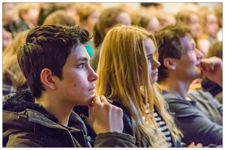The Niels Bohr Institute collaborates with school
The Niels Bohr Institute has partnered with a school, whose students were invited to the institute where researchers held a lecture on the scientific creation story, from the Big Bang to modern man.
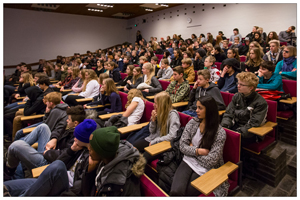
The Niels Bohr Institute has partnered with a lower secondary school and all 7th, 8th and 9th grades from the Sortedam School were invited to the institute where physicist Troels Petersen held a lecture on the scientific creation store – from the Big Bang to modern man.
“While science is playing an increasing role in our society and economy, it seems as though the interest in science and the number of science graduates cannot keep up with demand. The foundation for the interest in different subjects is typically established in primary school and that is why the Niels Bohr Institute, in collaboration with Sortedam School, will attempt to reverse this trend,” says Troels Petersen, associate professor of particle physics at the Niels Bohr Institute.
All 7th, 8th and 9th grades from the Sortedam School were therefore invited to a day at the university. The lecture took place at the Niels Bohr Institute in one of the large auditoriums, which was filled with students from the lower secondary school grades that morning.
“Welcome to the University,” exclaimed the enthusiastic Troels Petersen to the approximately 180 students who had met up early in the large auditorium, where they were presented with a lecture on the science of creation ‘From the Big Bang to the Modern Man’, which is based on the research and insights that Danish research contributes to.
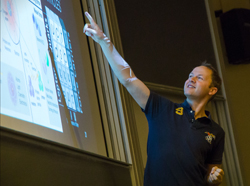
The energetic Troels Petersen gave the approximately 180 students a lecture about the science of creation ‘From the Big Bang to the Modern Man’, which is based on the research and insights that Danish research contributes to.
From the beginning
Troels Petersen began with Adam and Eve. “But it was not here that it started,” he said. “Research is not about what you think, but what you can prove. The modern picture of the universe began 13.8 billion years ago with the Big Bang. When the universe then cooled down to about 4,000 degrees, electrons and protons could get together and form the simplest atoms – hydrogen and helium. This was the beginning of the universe we know with stars, planets and galaxies,” he continued and went on explaining about the evolution of the universe and the evolution of life on Earth.
Troels Petersen hoped that the lecture would be an eye opener for everyone, but also an appetizer for those who have a taste for science. The lecture was presented in everyday language, so almost everyone understood most of it and the many questions that followed showed that it had created interest.
- Why does a supernova explode?
- How do we know how many galaxies there are?
- How can we know how old something we find is?
- How does gravity work? What created the Big Bang?
- What shape is the universe?
- When you look out into the universe, are you looking back in time?
No doubt the lecture had sparked a lot of thoughts and Albert from the 8th grade also thought that it was exciting to hear about such things from someone who knew so much about it.
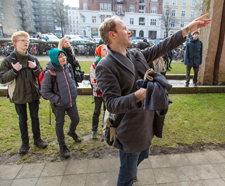
After the lecture, the students who were interested could follow him to a small auditorium on Blegdamsvej, where he went more in depth into the issues that had captured the students’ interest.
From dust to cool
After the lecture, the students who were interested could follow him to a smaller auditorium where he went more in depth into the issues that had captured the students’ interest. “There were 25-30 students and they were really in a class of their own and asked up to 15 good questions for each of my slides. Six of the students also would love to be a part of the future NBI Junior Study Academy and take on various challenges,” says a happy Troels Petersen, who thinks that the day was a success.
“The goal is both to foster general interest in science and to change the perception of science as being dusty and nerdy to being impressive and cool, but also to make sure to give young talent the opportunity to try their hand at science and equip them to be able to solve some of the challenges that lie ahead,” says Troels Petersen.
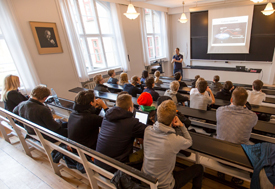
There were 25-30 students who attended the lecture for particularly interested students. Troels Petersen was impressed over how good the questions they asked were. Six of the students would also love to be a part of the future NBI Junior Study Academy and take on more challenges.
He points out that today’s lecture was a pilot project and thus a little experiment, so that they can improve the concept and create a future collaboration between the Niels Bohr Institute and the Sortedam School and other schools in the long term to give the opportunity for extra challenges to the most engaged and dedicated students. The concept of the NBI Study Academy could involve three phases: A lecture for everyone, discussion with those who are interested and assignments for the most talented.

